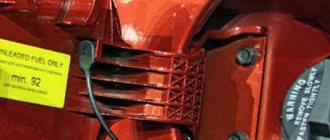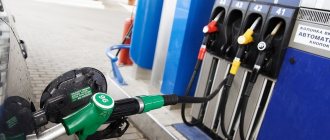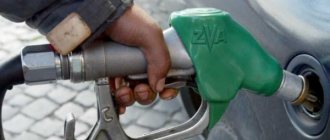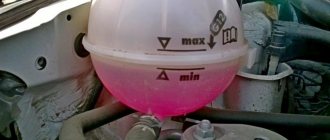Good day everyone!
What made me write this post? The answer is simple - comments received on my previous post with a personal review of the car, where I indicated the degree of gas mileage of my car. We all understand that everything is individual in fuel consumption, since it depends on many factors: engine characteristics, degree of load of the car, quality and compliance of the fuel brand, technical condition of the car, driving style, route and road circumstances, etc. factors. The obvious factor that each of us faces is the brand of gasoline and its quality.
As you know, for some time now 21129 engines have been installed in Largus. It was with this engine that I purchased my Ladushka in February of this year. Before buying my car, I doubted it for some time, because I wanted a car with a K4M engine, having justifiably read and heard a lot of reviews about the experience of the owners. But then, after thinking about it, taking into account the current circumstances, having not found a new car with the desired engine, I resigned myself and was inclined to buy a car with engine 21129. I will give comparative information on the characteristics of engines from RE -
Why the choice was made in favor of engine 21129: 1) market supply; 2) an engine with obviously better characteristics; 3) the opinion and experience of experienced people is undoubtedly good, but it still needs to be properly assessed, which is what was done.
I won't summarize anything. Everyone can look and draw their own conclusions, find answers to their questions regarding fuel.
Various recommendations
Loading …
You can often come across this question on various automotive forums, but no one can give a clear answer. Let's try to consider and come to a conclusion, what kind of gasoline is needed for this car?
Recommendations from the AvtoVAZ plant
Which of these will we choose for Largus?
According to the service book and manufacturer's recommendations, Largus must be filled with fuel with a medium or high octane number. So, the question arises, what kind of gasoline should be poured into the tank - AI-92, AI-95, AI-98, or the Premium and Euro varieties? In the same manual about the fuel system it is written that it is not lower than AI-95. This is due precisely to the effect on the fuel system, which better perceives this particular marking.
Renault engine manufacturer's recommendations
The factory recommendations are duplicated on the gas tank flap cover (only 95 and 98)
Since the Largus has a Renault engine, you should listen to this manufacturer when choosing gasoline.
An exact definition was found in the service book for the K4M and K7J engines. The fuel system must be filled with gasoline marked at least A-95E.
To reduce consumption, the manufacturer recommends using only 92 gasoline.
This fuel is designated AI-95 Euro on the domestic market.
Expert recommendations
In 2014, this car was tested on different types of fuel. Three cars with the same characteristics, into which AI-92, AI-95 and AI-98 were poured. Each of them was tested for different indicators.
When using AI-98, the engine overheated too much and the cooling fan could not cope. Therefore, experts noted that this brand of fuel is not very suitable for use in Lada cars.
When using AI-95, there was a noticeable increase in dynamics and a drop in consumption compared to AI-92. Thus, experts noted that the ideal option is to use this particular brand of fuel.
Motorists' experience
Experience says it's 95!
Based on the experience of motorists, we can say that AI-95 becomes the optimal option for use. After switching to this brand from AI-92, the dynamics noticeably increased, and the consumption decreased by almost 25%, which cannot but please the owners.
Also, auto mechanics note that when using AI-95, there is less deposits on the walls of the combustion chambers, and the fuel system becomes clogged and fails much less often. Therefore, it is recommended to fill Largus with this type of gasoline.
Economical driving
Or maybe 98th?
On some automotive Internet forums, in particular in the Ukrainian segment, the option of refueling the Lada Largus with gasoline with an octane number of 98 is actively discussed. This question, it seems, is very serious, taking into account the current offers of the petroleum products market, because over the years more and more “advanced” » fuel brands, and sometimes it’s difficult not to fall for advertising.
However, judging by the responses, this does not give much effect, because certain design features of the engine do not allow squeezing more out of the car in this situation. To achieve an increase in speed, you have to squeeze more out of the engine, and this entails additional fuel costs. As a result, taking into account the economics of the process, that is, the difference in price between the 95th and 98th brands, the car enthusiast only incurs additional costs.
Summarizing the results, we can draw one obvious conclusion - you should listen to the recommendations of the plant or “Premium Euro-95”. The use of higher octane gasoline, as mentioned above, does not provide the desired economic effect. By filling in gasoline with an octane rating of 92, the car owner worsens the driving properties of the car, the acceleration speed decreases, and consumption for a specific segment of the journey increases. And it’s not worth talking about what risk the engine is exposed to. It is unlikely to be wise to try to save money, thereby reducing the service life of the chassis.
Obviously, in each case, the owner of the car decides what to do, however, it is always worth taking into account information from open sources, reviews from motorists and recommendations of the manufacturer, which will allow you to comfortably operate your Lada Largus, enjoying your trips, and not expose the mechanism to additional risk.
Lada Largus which gasoline is 92 or 95?
Answer the question “which gasoline 92 or 95 is better in Lada Largus?” There is only one word - quality. In practice, VAZ and Renault engines work perfectly on 92 gasoline, but provided that the gasoline is of high quality and not degraded. But, we live in Russia and, alas, high-quality fuel cannot be found at any gas station. In the article on replacing the Lada Largus fuel filter, we showed what the filter element looks like after 100 thousand kilometers on our gasoline.
To at least somehow protect your car from poor-quality refueling, try to refuel only in trusted places or at network gas stations. Such gas stations monitor the quality of gasoline much more often and very rarely deal with diluted gasoline. The same cannot be said about small gas stations that resort to similar tricks to “stay afloat.”
Fuel costs.
Fuel consumption varies for each Largus model. And the Ministry of Transport calculates the indicators relative to the standard fuel consumption for the Lada Largus under ideal driving conditions. Therefore, official data often differs from real figures.
Fuel consumption for 8-valve models
Engines of this type include cars with engine power of 84 and 87 horsepower. According to official statistics, gasoline consumption on the 8-valve Lada Largus is 10.6 liters in the city, 6.7 liters on the highway and 8.2 liters with mixed driving.
The actual figures for gasoline costs look a little different.
A review of numerous reviews from the owners of this car has the following results: city driving consumes 12.5 liters, country driving about 8 liters and in the combined cycle - 10 liters.
Winter driving increases fuel consumption, especially in severe frosts, and it increases by an average of 2 liters.
Fuel consumption of a 16-valve engine
The car’s engine with a power of 102 horsepower is equipped with 16 valves, so the fuel consumption rate of the Lada Largus per 100 km is characterized by an increase in its performance.
Just in case
Previously, at VAZ, for example, there was a certain unity of views; they believed that the 95 was better. And the arguments were simple: environmental friendliness, efficiency, acceleration, etc. Well, and a backup argument - a technological reserve that is laid down by the designer just in case. That is, if by pure “accident” you are flooded with something worse than 95, then nothing will happen to your engine.
Today there is no point in developing engines for the same 92nd. If only because in Europe there are no such figures anymore. The lower limit today is still 95.
About reducing fuel consumption during the running-in process
When measuring fuel consumption, the manufacturer uses new cars and a certain type of route. However, as the mileage increases, the amount of fuel required per 100 kilometers changes. Most often, a more economical situation is noted.
So, for example, for a range of up to 30,000 kilometers, the rate of fuel consumption for every 100 kilometers is 9.3 liters. If we take the same route, but the car’s mileage will be twice as long (60,000 kilometers), then the consumption rate will decrease and will be 8.3 liters. Such figures make it possible to determine at what point the vehicle's running-in was completed.
Thus, at this stage, fuel consumption, regardless of the type of body (station wagon, van), will always be higher than after the end of the run-in.
Gasoline Lada Largus according to GOST
When we arrive at a gas station, we most often pay attention only to the octane number printed on the column. However, fuel has other designations that you need to pay attention to.
For Lada Largus with French engines, it is recommended to use unleaded gasoline with an octane rating of at least AI-95. Premium-95 according to GOST R 51105 or Premium Euro-95 according to GOST R 51866 is perfect.
For Russian engines, unleaded gasoline AI92 of classes K3, K4 and K5 is perfect, for example Regular-92 according to GOST R 51105-97.
Real fuel consumption figures
Despite the large volume of clinical tests that all cars undergo before being placed on the market, the gasoline consumption of the Lada Largus presented in the technical data sheet may differ significantly from the actual figures. They can be influenced by various factors, both external and internal, so each owner of such a vehicle may have his own numbers.
Lada Largus 1.6 and 84 l with
The smallest engine can produce 84 horsepower. The maximum speed it can reach does not exceed 155 km/h. At the same time, the cylinder volume is 1.6 liters. It has only 8 valves, so it is considered the least powerful.
In the city, the consumption of the Lada Largus 1.6 is 12.3 liters, on the highway no more than 7.2 liters, and in mixed driving 7.5 liters.
If you calculate the indicators for a cargo or passenger type body, the data will be almost identical. A station wagon requires the least amount of fuel.
Lada Largus 1.6 and 90 l with
For cars with a 90 horsepower engine, despite similar technical characteristics to the previous model, the consumption will be different. In practice it amounts to:
- highway - 7.0 liters;
- city - 12.4 liters;
- mixed type - 7.7 liters.
Thus, even with a more powerful engine, for indicators such as the highway, a savings of 200 grams is noticeable.
Lada Largus 1.6 and 105 l with
The most powerful model has 105 horsepower and 16 valves under its hood. This makes it possible to accumulate a small reserve of power for critical circumstances. At the same time, the acceleration occurs more confidently and quickly.
How does the car manual answer this question?
So, to answer the question of whether it is possible to fill Granta with 92 gasoline, which worries many motorists, you should open the instructions on Appendix 1, which states that the recommended gasoline is “Premium 95” or “Premium Euro 5”. Why do the instructions contain such strict restrictions regarding gasoline?
Let's figure it out. The first note states that the required flammability at low temperatures must be ensured.
It follows from this that fuel must be selected of a certain volatility class. In different regions of the Russian Federation, this requirement is adhered to differently, and fuel volatility classes differ from each other based on location.
The second obstacle to the use of low-octane gasoline is various metal and organic particles, which are anti-knock agents and are contained in gasoline. The presence of lead, cadmium, manganese, iron and other metals can be observed in the particles.
Various additive materials are introduced into high-octane gasoline to prevent the formation of soot, various deposits and corrosion. But these substances can only be included in gasoline by its manufacturer. Every motorist can do this, but experts do not recommend doing this, since substances can be introduced in the wrong proportion.
FakeHeader
Comments 113
Good afternoon. Lew A95. Previously I tried A92, which is recommended by the manufacturer. Why did you switch to A95? 1. I don’t see any point in saving too much, since the difference in cost is small. In addition, in my opinion, the amount of 5,000 rubles. scattered over a year is absolutely miniscule. 2. I only pour gasoline at proven gas stations. It’s easier to waste money at poorly established gas stations and then argue about everything. The car drives in any case, but the driving mode on the A95 is quieter, calmer and feels more dynamic. 3. I did not specifically compare the costs of this or that gasoline. I wrote a review with personal observations about the car, including current fuel consumption after running-in. In general, I must note that my expenses, in my opinion, are quite good. I am satisfied with everything. 4. For some time now I have been keeping records of gas stations. I'll analyze the data someday. There is no time yet.
Fuel consumption on the highway
To determine a more accurate indicator of fuel consumption, it is necessary to consider traffic within the city and on the highway. In the second cycle, this figure will always be less, since the vehicle’s movement is smooth and stable. Most often, when driving in suburban areas, they stick to maintaining the same speed.
For Lada Largus cars, real gasoline consumption outside the city is 6.7 -7.2 liters per 100 kilometers; according to technical documentation, it is in the range of 6.4 - 6.7 liters per 100 kilometers.
New generation Lada
The presentation of Lada Largus, which is a joint project of VAZ and Renault, took place in 2011. The purpose of inventing this version of the Lada was to make the 2006 Dacia Logan similar to the Romanian car, suitable for Russian roads.
| Model | Consumption (highway) | Consumption (city) | Consumption (mixed cycle) |
| Lada Largus | 6.7 l/100 km | 10.6 l/100 km | 8.2 l/100 km |
Technical characteristics of the Lada Largus, fuel consumption and maximum speed for all models are almost the same
. The main configuration parameters include:
- Front-wheel drive;
- 1.6 liter engine;
- 5-speed manual transmission;
- The fuel used is gasoline;
Each car has an 8- and 16-valve engine, except for the Cross version. It is equipped only with a 16-valve engine. The maximum speed of the car is 156 km/h (with engine power of 84, 87 horsepower) and 165 km/h (engine with 102 and 105 horsepower). Acceleration to 100 kilometers is carried out in 14.5 and 13.5 seconds, respectively. The average fuel consumption of Largus per 100 km in the combined cycle is 8 liters.
What determines actual gasoline consumption?
If the fuel consumption standards for a vehicle depend on the technical characteristics of the model (engine power, number of valves, cylinder volume), then the actual consumption is related to:
- Low quality fuel. Since at many gas stations special additives are added to gasoline to increase the octane number, traffic movement may become difficult, which causes an increase in consumption.
- A large number of electrical equipment in active mode. Since the operation of such elements requires energy, they actively take it away from the car, which also affects the increase in consumption. Moreover, this happens not only in Lada models, but also in any other brand.
- Engine heating. During the winter, a large share of gasoline is spent on these needs.
- Production of engine parts. The presence of problems in the fuel, exhaust, or cooling systems has a direct impact on fuel consumption, significantly increasing it. One of the signs of such a problem is the changed color of the exhaust gases.
- The terrain. While the driver may not visually notice a small hill, the car feels every bump. If the load increases with ascent, then the volume of fuel consumed changes accordingly, and vice versa, if the car is driving on a descent, then this indicator decreases.
- Weather conditions. With a strong tailwind, the car receives a small level of deceleration, so to eliminate it it is necessary to apply a greater load, as a result of which gas mileage changes. When driving in the rain, the car also spends more energy due to an increase in the rolling resistance of the tires, which also affects the amount of fuel consumed.
- Workload. Each passenger increases the weight of the vehicle, and therefore the gasoline consumption by several percent.
- The driver's driving style. With a sharp start and braking, the level of fuel consumed increases. On the contrary, during smooth movements with coasting, it decreases.










